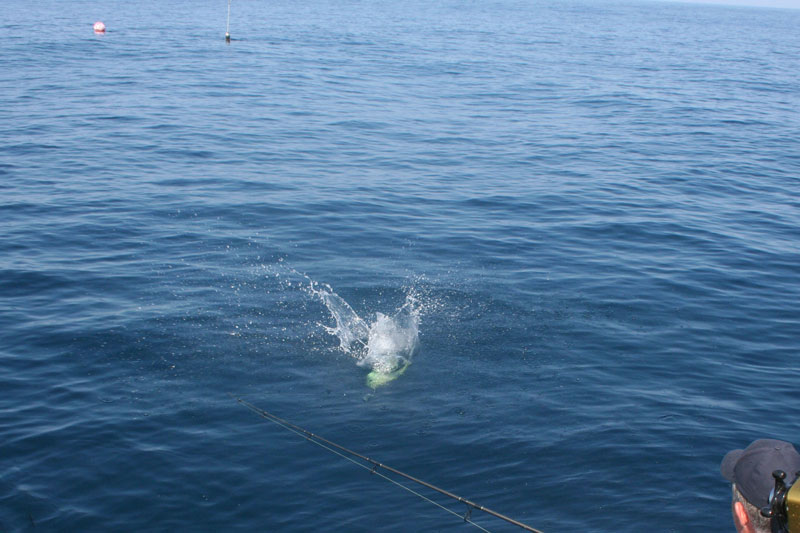Whether you’re a dozen miles from the inlet, 30 miles out, or 60-plus miles at the Baltimore Canyon, any time you see the floats of commercial fishing pots you’re in luck. All too often people run right past those floats and balls without giving it a second thought – yet pulling back on the throttles for a moment might result in bent rods and a full fishbox.

10 Miles and Change
Fields of bass pots 10-plus miles from the inlet present three distinct opportunities: sea bass, flounder, and possibly mahi-mahi. You know there’s good bottom below because those commercial guys don’t waste their time setting out bass pots where there aren’t any sea bass; dropping cut squid or clam baits on top-and-bottom rigs is likely to be effective on the bottom fish. Another option is to rig up with four to eight-ounce jigs, add to their appeal by sliding a squid strip over the hook, and gently jig the offering just above bottom. (See Deepwater Doormats, for more on targeting flatfish in the open ocean).
There’s also a good shot at finding flounder in these areas, where top-and-bottom fluke killers dressed with five-inch GULP! Swimming Mullet in white, chartreuse, and pink is often the best bet. Try to locate several chunks of structure or interesting-looking bottom on the meter, then drift alongside it. Flounder do tend to hang out in groups in the inshore reef sites so when you catch one, repeat the drift.
Some seasons, mostly depending on water clarity and temperature, mahi-mahi can also be found swimming around the inshore bass pots. True, they’ll usually be smaller than those found farther from the inlet and most will be just a couple-few pounds, but on occasion a 10 or 15 pounder will show up to keep things interesting. (Visit Bass Pot Battlegrounds) to see more on how to target mahi in specific when they visit these inshore waters.
It’s Getting Deeper
When you see those floats in deeper waters, usually 200 to 350 feet, you’ve just discovered prime waters for mahi, sea bass, and also blueline tilefish. This far out the presence of dolphin grows likelier, and bailing the pots can be a reliable fishery through the summer months.
Fishing bottom in this depth range you’ll often encounter a mix of bass and bluelines, plus an occasional fourspot flounder. In all of these cases dragging bottom with a meat-rig baited with squid, cut fish, or clam is effective, though considering how long it takes to drop down and reel up the lines, it’s smart to stick with tough baits that don’t get stolen too often. Baited jigs are also an excellent option for targeting these fish. Again, we have a feature focusing on this fishery in specific; check out Bass ‘N Blue for the specifics.
Over the Edge
At the edge of the Continental Shelf, usually in the 500- to 800-foot range, you’ll often encounter high-fliers and polyballs. Trollers looking for marlin, tuna, and mahi-mahi often utilize a flight plan of trolling in a general north or south direction while zig-zagging from pot to pot, which can prove effective at times. Simple enough. But if you want to create carnage aboard your boat, consider bailing for mahi.

Light-tackle anglers often utilize this method, pot-hopping from one polyball to the next, tossing chunks and baited circle hooks on spinning gear. Some years, this proves to be the most reliable offshore fishing available and most or all of the pots will be loaded up with schools of dolphinfish ranging from a half a dozen to fish numbering in the OMG range. The basic tactic is simple: approach a pot from the down-wind or down-current side (whichever is prevailing, so you drift away from the commercial gear and not into it), shift your boat into neutral, and toss a handful of fish chunks over the side. Then, anglers fling out their bait chunks in the same vicinity. When fish are present in good numbers you’ll usually see them dart out and go into a frenzy – and quite regularly, multiple hook-ups and mahi-mahi mayhem ensue.
Often you can keep the school of fish right next to your boat and hook one after the next, either by continuing to entice them with chunks or by keeping one hooked fish in the water next to the boat. On rare occasions, however, the fish will play hard to get. If you see them but can’t get them to bite, there are couple of near-surefire ways to get them into feeding mode. One is to throw handfuls of live bull minnow into the water. Obviously, you’ll need to plan ahead and leave the inlet with a full livewell, but if you do so and then start tossing minnow within eyesight of the mahi, it’s incredibly rare for them to not go into an utterly insane feeding frenzy.
The second trick is to toss out a wiggling squid. No, you can’t easily procure live squid. What you can do is grab a couple boxes of regular squid at the tackle shop, and let them thaw as you cruise out. Rig a rod with a five- to seven-foot 30-pound flouro leader, clip off the tip of a squid’s mantle, and run the leader down through the resulting hole and out by the squid’s tentacles. Then run a half-ounce egg sinker up the leader prior to tying on a 10/0 circle hook. Gently cast it out towards the pot, and allow it to free-fall. As it sinks, the tentacles will ripple and wave with a mesmerizing, life-like action that mahi-mahi just can’t resist.
So: are you ready to harness every opportunity that presents itself when you head out into the open Atlantic? Remember, hope springs eternal – and those floats mean fish.